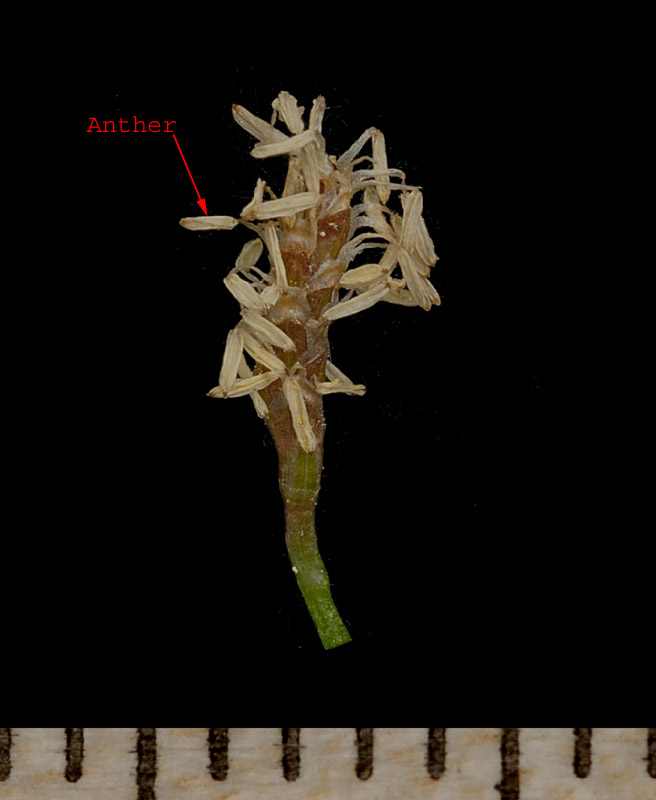 | Concinna:
Answers to key questions in Sedges (Carex) of Saskatchewan, Fascicle 3,
Flora of Saskatchewan by Anna Leighton leading to this species. The
answers are in the order you would normally work through the key.
 |
Stigmas 3;
achenes three-sided, occasionally terete, though their shape may be
concealed by flattened perigynia. NOT [stigmas 2; achenes
lenticular] |
 |
Spikes 2
or more per culm, terminal and lateral; spike bracts present on lateral
spikes (except in Section Phyllostachyae), lowest bract usually
evident, often conspicuous. NOT [Spikes 1 per culm, terminal;
spike bracts absent]. |
 |
Lower
pistillate scales not bract-like or leaf-like but similar in size and
shape to individual perigynia (up to twice as long as perigynia in C.
magellanica ssp. irrigua). NOT [Lower pistillate scales
resembling green, leaf-like bracts much longer and wider than individual
perigynia] |
 |
Perigynia
sparsely to densely pubescent or puberulent (in C. pedunculata
pubescence represented by very short hairs scattered near tip; in some
species of Sect. Acrocystis, perigynia may be glabrous or
virtually hairless, but all members of this group have convexly 3-sided
to terete achenes with tight fitting perigynia and a stipe-like base
about equal to beak in length). NOT [Perigynia glabrous.] |
 |
Perigynia
usually less than 5 mm long but if longer, beak distinctly shorter than
perigynium body; pubescence various. NOT [Perigynia 5-7 mm long with
beak as long as or longer than perigynium body; pubescence on the
perigynia dense, stiff and pointing toward tip] |
 |
Achenes
with +/- flat sides; perigynia loosely fitting achene and variously
shaped in cross-section, densely to sparsely pubescent (faintly
puberulent with very short hairs scattered near tip in C. pedunculata);
pistillate spike bracts sheathing or sheathless. NOT
[Achenes convexly 3-sided to terete; perigynia tightly enclosing achenes
and convexly 3-sided to terete, sparsely pubescent, (rarely glabrous in C.
deflexa and C. rossii, pubescent only on ribs in C. tonsa);
stipe-like base about equal to beak in length; pistillate spike bracts
sheathless. Section Acrocystis (C. deflexa, C.
inops ssp. heliophila, C. peckii, C. rossii, C.
tonsa, C. umbellata).] |
 |
Beak up to
0.5 mm long and lacking teeth; lowest spike bract blade shorter than
lowest spike. Section Clandestinae (C. concinna, C.
pedunculata, C. richardsonii). NOT [Beak 0.5-2 mm long,
distinctly bidentate; lowest spike bract blade at least twice as long as
lowest spike, and often as long as inflorescence. Section Paludosae
(C. houghtoniana, C. lasiocarpa, C. pellita).] |
 |
Pistillate
scales acute, obtuse or rounded, awnless; perigynia 2-3.3 mm long with
tapering base, visibly pubescent with white hairs; terminal spike
staminate. NOT [Pistillate scales abruptly awned; perigynia 3.5-5
(6) mm long with stipe-like base about half the total length, faintly
puberulent with scattered, very short, straight hairs near tip (best
seen in profile along edges); terminal spike usually androgynous,
sometimes staminate.] |
 |
Spikes
overlapping or densely bunched at culm tip; pistillate spikes globose to
ovoid-ellipsoidal, 4-8 mm long by 3-4 mm wide; staminate spike 4-7 mm
long; sheath of lowest bract 1-5 mm long, red only with age; pistillate
scales half as long as perigynia. NOT [Spikes separate to
overlapping; pistillate spikes longer than wide, 5-16 mm long by 3-4 mm
wide; staminate spike (7) 11-23 mm long; sheath of lowest bract 6-15 mm
long, red-brown, conspicuous; pistillate scales as long as, or longer
than, perigynia.] |
|

